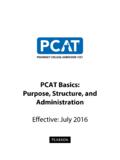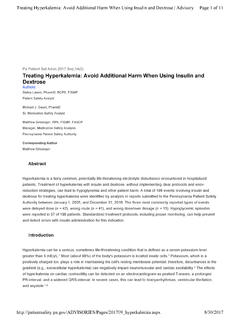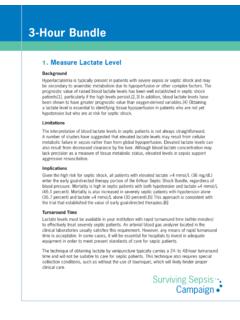Transcription of PCAT Test Blueprint & Sample Items
1 PCAT Test Blueprint and Sample Items Biological Processes Biological Processes Objectives B1. General Biology B2. Microbiology A. Cellular and Molecular Biology A. Microorganisms 1. Structure and functions of cells B. Infectious Diseases & Prevention 2. Gene expression C. Microbial Ecology 3. Cell division and growth D. Medical Microbiology 4. Energy transformations E. Immunity 5. Metabolism B3. Human Anatomy and Physiology B. Diversity of Life Forms A. Structure 1. Genetics 1. Cells F. Health 2. Tissues 1. Nutrition 3. Organs 2. Diseases B. Systems 3. Drugs 1. Skeletal/muscular/nervous 2. Circulatory/respiratory 3. Excretory/digestive 4. Endocrine/reproductive 5. Integumentary/immune Copyright 2016 by NCS Pearson, Inc. All rights reserved. PCAT Test Blueprint and Sample Items 2. Examples of Biological Processes Items Biological Processes Items may be presented either standing alone (Biology Example 1 4). or associated with a short passage (Biology Example 5). Stand-alone Items can be answered independent of any passage or other item, while Items associated with a passage will require understanding part or all of the passage in order to answer them correctly.
2 X Each Biological Processes item stem will be in the form of a question (followed by a question mark) or in the form of an incomplete sentence that requires completion (with no end punctuation). Options may contain more than one concept or piece of information but each one will plausibly relate to the stem. In the following Sample Biological Processes Items , the correct answer for each item is followed by and asterisk (*), and each answer option is followed by a bracketed explanation for why it is correct (CA) or incorrect (neither of which will appear in the actual test). Biological Processes Example 1. Content Objective: B2E. Any molecular configuration that triggers the formation of the lymphocyte immune response and is itself the target is called a(n). A. leukocyte. [A leukocyte is a white blood cell and not the target of an infection from a foreign molecule.]. B. eosinophil. [Eosinophil is a type of white blood cell that is involved in the immune response to parasitic infections or allergic reactions and not the target of infection from a foreign molecule.]
3 ]. C. immunoglobulin. [Immunoglobulins are antibodies formed by B cells and not the targets of an infection from a foreign molecule.]. D. antigen. *. [CA: $QWLJHQ is the correct term for anything that is the target of the immune response, causing production of antibodies by the living organism. Antigens can include foreign pollen, bacteria, viruses, proteins, and some other materials.]. Copyright 2016 by NCS Pearson, Inc. All rights reserved. PCAT Test Blueprint and Sample Items 3. Biological Processes Example 2. Content Objective: B1F2. Emphysema is a lung disease that impairs the exchange of oxygen and carbon dioxide, resulting in which condition? A. Respiratory alkalosis [Respiratory alkalosis is due to alveolar hyperventilation leading to decreased plasma carbon dioxide concentration. It develops when the lungs remove more carbon dioxide than is produced in the tissues. It is a common finding in patients receiving medical ventilation. Emphysema results in a decreased expulsion of carbon dioxide.
4 ]. B. Metabolic alkalosis [This conditions results from an altered metabolism. A decreased hydrogen ion concentration results in increased bicarbonate and carbon dioxide concentrations. It occurs most commonly when a person has been vomiting profusely. Emphysema results in a decreased expulsion of carbon dioxide.]. C. Respiratory acidosis *. [CA: Respiratory acidosis is a clinical disturbance that is due to alveolar hypoventilation. It results in low blood pH due to decreased clearance of carbon dioxide by the lungs. This condition occurs in emphysema as exhalation becomes insufficient.]. D. Metabolic acidosis [Metabolic acidosis is a condition in which the blood pH is low due to increased production of hydrogen ions by the body or the inability of the body to form bicarbonate in the kidney. Emphysema results in a decreased expulsion of carbon dioxide.]. Copyright 2016 by NCS Pearson, Inc. All rights reserved. PCAT Test Blueprint and Sample Items 4. Biological Processes Example 3. Content Objective: B1B1.
5 A child is born with trisomy 21. DNA testing using a polymorphic DNA marker for chromosome 21 revealed the pattern exhibited in the Southern blot below. Father Mother Child At which meiotic division did nondisjunction occur? A. Maternal meiotic division I *. [CA: Nondisjunction is an error that can occur during meiosis or mitosis, causing the daughter cells to have too many or too few chromosomes. Because the child has two maternal alleles that are not identical and one paternal allele, nondisjunction occurred at this stage of division.]. B. Paternal meiotic division I. [If nondisjunction occurred here, the child would have two paternal alleles and one maternal allele.]. C. Maternal meiotic division II. [If nondisjunction had occurred here, the maternal contribution would have been either no allele or two of the same kind.]. D. Paternal meiotic division II. [If nondisjunction had occurred here, the paternal contribution would have been either no allele or two of the same kind. Since there are two that appear to be of maternal origin, there is only one of paternal origin.]
6 ]. Copyright 2016 by NCS Pearson, Inc. All rights reserved. PCAT Test Blueprint and Sample Items 5. Biological Processes Example 4. Content Objective: B3B3. Which sphincter in the gastrointestinal tract controls movement of chyme from the stomach into the small intestine? A. Cardiac [The cardiac sphincter (lower esophageal sphincter) is located at the junction of the esophagus and the stomach.]. B. Pyloric *. [CA: The pyloric sphincter separates the stomach from the duodenum, the first division of the small intestine. The pyloric sphincter normally is in a contracted state, and retains food within the stomach until it has been broken down mechanically and chemically into chyme that can be passed into the duodenum of the small intestine.]. C. Ileocecal [The ileocecal sphincter is located at the junction of the small intestine (ileum) and the large intestine.]. D. Anal [The anal sphincter is located at the end of the rectum.]. Copyright 2016 by NCS Pearson, Inc. All rights reserved. PCAT Test Blueprint and Sample Items 6 Biological Processes Example 5: Passage and Accompanying Item Chronic Stress and Immunity Stress is an intrinsic part of life for most organisms, and dealing successfully with stressors enables survival.
7 Early studies in rats showed that acute stress results in a redistribution of leukocytes from the blood to other organs such as skin, lymph nodes, and bone marrow, and that adrenal stress hormones are the major mediators of this response. Because the skin is one of the targets to which leukocytes traffic during stress, researchers hypothesized that such a leukocyte redistribution may increase immune surveillance and consequently enhance immune function if skin is exposed to an antigen after acute stress. To test this hypothesis, researchers examined the effects of acute stress on skin immunity by exposing rats to containment in a restraining cage (see partial results below in Table 1). Physical restraint activates the sympathetic nervous system and the hypothalamic-pituitary-adrenal axis, and results in the activation of adrenal steroid receptors throughout the body. Results showed larger numbers of leukocytes in the skin of stressed animals both before and after exposure to an antigen.
8 In contrast to the immunoenhancing effects of acute stress, researchers found that chronic stress significantly suppressed the immune response. An adrenalectomy eliminated the stress- induced enhancement of skin immune response. Table 1: Physiological Change from Baseline in Response to Stimuli Bronchiole Bone Marrow Stimulus Heart Rate Diameter Leukocytes A Increase Decrease Increase B Increase Increase Increase C Decrease Increase Decrease D Decrease Decrease Decrease Copyright 2016 by NCS Pearson, Inc. All rights reserved. PCAT Test Blueprint and Sample Items 7 Biological Processes Example 5. Objective: B3B3. If the study described in the passage had examined the effects of an acute stressor on digestion, the information in the passage would best support the prediction that A. peristalsis would be increased. [Sympathetic activation results in decreased rather than increased peristalsis.]. B. intestinal motility would be decreased. *. [CA: According to the passage, an acute stressor results in activation of the sympathetic nervous system.]
9 Sympathetic effects on digestion include decreased intestinal motility and peristalsis, decreased salivation, and increased anal sphincter tone.]. C. salivation would be increased. [Sympathetic activation results in decreased rather than increased salivation.]. D. anal sphincter tone would be decreased. [Sympathetic activation results in increased rather than decreased anal sphincter tone.]. Copyright 2016 by NCS Pearson, Inc. All rights reserved. PCAT Test Blueprint and Sample Items 8. Chemical Processes Chemical Processes Objectives C2. General Chemistry C3. Organic Chemistry A. Atomic Theory A. Structure and Properties 1. Structure 1. Structural formulas and bonding 2. Ions 2. Properties of organic compounds 3. Periodicity B. Reactions of Organic Compounds B. Chemical Bonding 1. Oxidation reduction reactions 1. Nomenclature/formulas 2. Hydration and dehydration 2. Bonding 3. Hydrolysis C. Reactions and Reaction Mechanisms 4. Addition/substitution/elimination 1. Types of reactions C4.
10 Basic Biochemistry Processes 2. Balancing equations A. DNA and RNA. 3. Equilibrium B. Lipids 4. Stoichiometry C. Proteins D. Kinetic Theory 1. States of matter 2. Gas laws 3. Causes and effects of changes in states E. Solutions 1. Concentration (pH). 2. Solubility 3. Acid base theories G. Nuclear Chemistry: Radioisotopes Copyright 2016 by NCS Pearson, Inc. All rights reserved. PCAT Test Blueprint and Sample Items 9. Examples of Chemical Processes Items Chemical Processes Items may be presented either standing alone (Chemical Processes Example 1 4) or associated with a short passage (Chemical Processes Example 5). Stand-alone Items can be answered independent of any passage or other item, while Items associated with a passage will require understanding part or all of the passage in order to answer them correctly. x Each Chemical Processes item stem will be in the form of a question (followed by a question mark) or in the form of an incomplete sentence that requires completion (with no end punctuation).








